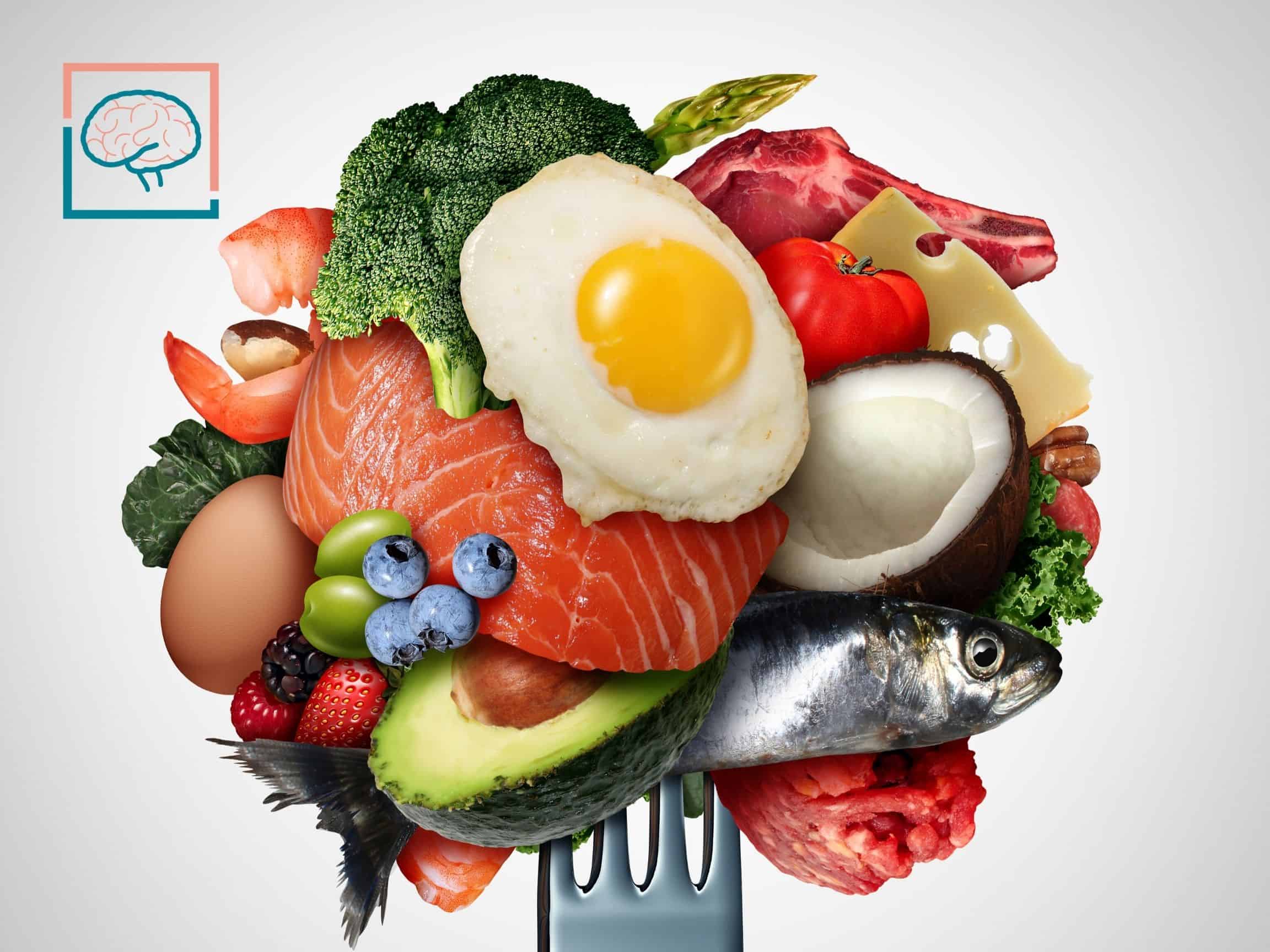One of the most challenging aspects of neurodegenerative diseases like Alzheimer’s disease is the lack of effective treatments. Even after decades of scientific research and clinical trials, no drugs have been discovered that can really make a difference.
The good news is there’s an option that shows great promise: a ketogenic diet (or keto diet). Unfortunately, this holistic treatment does not get the recognition that it deserves.
KetoFLEX for Alzheimer’s is also called the Bredesen Diet and is part of the Bredesen Protocol. Developed by Dr. Dale Bredesen over decades of research, KetoFLEX is a modified keto diet designed to aid in preventing and reversing cognitive decline.
Want to prevent Alzheimer’s using a plan that works… without breaking the bank? Get our guide to the Bredesen Protocol on a budget for $29.
What Is KetoFLEX?
What is KetoFLEX? KetoFLEX is a high-fat, mildly ketogenic diet that involves eating highly nutritious whole foods, including many plant-based foods. It’s a natural treatment for cognitive dysfunction that incorporates intermittent fasting and is optimized for brain health.
The standard keto diet was initially developed to treat epileptic children who didn’t respond to medication. Following a stringent ketogenic high-fat diet helps reduce and eliminate seizures in these children.
Keto diets focus on eating lots of fats and eliminating carbohydrates almost entirely to maintain blood ketone levels, which is hard to do. They go beyond a typical low-carb or Atkins diet and severely restrict carbohydrate intake.
However, a strict keto diet may not be ideal for patients facing Alzheimer’s and cognitive decline.
KetoFLEX differs from the standard keto diet. With KetoFLEX, you’ll eat slightly more carbohydrates than you would on a traditional keto diet. KetoFLEX allows the body and brain metabolic flexibility to use either glucose or ketones for fuel, hence the name.
The KetoFLEX diet is also different because it incorporates intermittent fasting, which has neuroprotective benefits. The full name of KetoFLEX is actually KetoFLEX 12/3 because you fast for 12 hours total, starting at least 3 hours before you go to bed.
What Happens To The Brain In Alzheimer’s?
Alzheimer’s disease is a specific type of cognitive impairment or dementia where beta-amyloid plaques and tau tangles develop inside brain cells (neurons). These structures keep the neurons from functioning correctly, and the dysfunction eventually leads to neuronal cell death.
Another unique characteristic of neurons in a brain with Alzheimer’s is the inability to use glucose for energy. Cells in our bodies prefer to use glucose for energy, particularly neurons.
Alzheimer’s neurons are different. Neuroscience has shown Alzheimer’s neurons develop insulin resistance and struggle to take up and utilize blood glucose as a source of energy. They’ll run out of energy if they can’t find an alternative source, which is where ketones come in.
It’s also harder for insulin to reach the brain through the blood-brain barrier in Alzheimer’s patients, amplifying these effects.
The Science Behind KetoFLEX
How does KetoFLEX work? KetoFLEX works by providing the brain with ketones it can use as energy when it can’t use glucose, which can happen in Alzheimer’s disease. KetoFLEX also combines the brain health-promoting effects of intermittent fasting and nutrient-rich anti-inflammatory whole foods.
Entering Ketosis
The “keto” part of KetoFLEX refers to bringing the body into ketosis. Ketosis happens when you eat very little glucose and the body shifts to producing ketone bodies from fats. Our cells can use ketone bodies like they use glucose to produce energy in their mitochondria.
If you want to have sustained ketosis, you must eat a high-fat, low-carbohydrate diet. Low-fat diets don’t provide the fatty acids the body needs to produce ketones.
The brain can use both glucose and ketone bodies as a fuel source. Even if neurons develop insulin resistance, which is common in dementia patients, the brain’s neurons can still take up and use ketones.
A diet that produces ketones, like KetoFLEX, can give the brain the mitochondrial fuel it needs if glucose is no longer a viable fuel.
Can ketones slow down Alzheimer’s? Evidence is mounting that ketones can slow down Alzheimer’s as part of a ketogenic diet. They may also help improve cognitive function and memory in Alzheimer’s patients.
Fasting Windows
The KetoFLEX diet also incorporates short intermittent fasting windows. With intermittent fasting, you eat within a shortened period of time each day.
Intermittent fasting reduces insulin resistance, one of the hallmark symptoms of Alzheimer’s disease in neurons. It also helps improve insulin sensitivity so that Alzheimer’s-induced changes in glucose metabolism aren’t as harmful to the body and brain.
Metabolic Flexibility
One of the ways that KetoFLEX is a vast improvement over the standard keto diet is metabolic flexibility. It can be challenging to maintain true ketosis, and ketosis can have many side effects like the “keto flu.” KetoFLEX lets the brain use both glucose and ketones for fuel.
Great Sleep
Ketone bodies appear to play an important part in regulating sleep. When your body generates sufficient ketones, it helps improve the quality of your sleep.
Benefits of KetoFLEX
As discussed above, in addition to preventing or reversing cognitive decline, the KetoFLEX diet has helped some patients with:
- Improved cognition and brain function
- Improved insulin sensitivity
- Reduced inflammation
- Weight loss
- Protection against cardiovascular disease
- Better sleep
The Best Bresden Protocol Foods
The best foods for the Bredesen Protocol are what you might expect of a modified Mediterranean diet. There is a big emphasis on healthy fats, omega-3-rich proteins, and low-glycemic carbohydrates. Some ideal foods for the Bredesen Protocol are:
- Non-starchy vegetables such as cruciferous vegetables (Brussels sprouts, broccoli, cauliflower, for example) and leafy green veggies (like spinach, kale, and arugula)
- Extra virgin olive oil
- Coconut oil: Coconut oil is full of healthy fatty acids to help induce ketosis, including keto-friendly medium-chain triglycerides (MCTs).
- Wild-caught seafood rich in healthy fats like salmon, sardines, and mackerel
- Grass-fed meat, in moderation
- Gluten-free foods: Gluten can also cause inflammation.
- Prebiotic foods: Prebiotics help support the healthy microbes in your gut. The balance of your gut microbiome and gut health is directly correlated with Alzheimer’s. Green bananas, jicama, and artichoke hearts are all great sources of prebiotic fiber.
- Probiotic foods: Fermented foods like kimchi and sauerkraut are loaded with probiotics.
- Foods with lots of resistant starch: These foods help feed your good gut microbes. Legumes, cassava root, and pistachios are all great sources of resistant starch.
- Herbs and spices for flavor, like basil, cilantro, ginger, and garlic
It’s also okay to enjoy occasional “indulgences” on the KetoFLEX plan, including calorie-free natural sweeteners (stevia, monk fruit), cacao, and red wine.
This isn’t an exhaustive list of everything included in the KetoFLEX plan, but it should give you an idea of what foods would be suitable. You’ll want to talk to a healthcare professional before starting KetoFLEX to design your ideal eating plan.
Foods To Avoid On KetoFLEX
There are a few foods that you should avoid on the KetoFLEX diet. You should eliminate many of these foods from your diet in general because they cause harmful inflammation.
- Simple carbohydrates and high-glycemic foods: For your overall health, it’s wise to avoid high-carbohydrate, high-glycemic foods. These foods cause inflammation throughout the body, including in the brain.
- Gluten and dairy: Both of these may increase inflammation. If you must have some sort of carb, choose whole grains over processed ones.
- Starchy vegetables: Starchy vegetables can spike your blood sugar, leading to inflammation.
- Artificial sweeteners and food colors
- Processed foods and preservatives
All of these foods put unnecessary stress on the body and can contribute to inflammation.
How To Get Started On KetoFLEX
You can get started on KetoFLEX by talking to a doctor trained in the Bredesen Protocol. It’s certainly worth starting this discussion early if you have a high risk of developing Alzheimer’s. Those at an increased risk of Alzheimer’s include:
- Those who have the E4 variant of the APOE gene (ApoE4)
- People with a family history of Alzheimer’s
- People with cardiovascular disease and/or type 2 diabetes
- Those who have obesity
- Older adults
If you fall into one of these categories, or you’re a caregiver of someone who does, don’t put off looking into the Bredesen Protocol. This revolutionary concept can be instrumental in preventing or reversing cognitive decline.
Don’t be fooled: Bredesen Protocol is more holistic than simply changing your diet. Keeping physically and mentally active, addressing pathogens and toxins, reducing stress, and more are vital parts of this method.
When following the Bredesen Protocol with an expert, you’ll also need to have lab work done and an individualized care plan made. A healthcare professional can keep a close eye on the levels of cholesterol and other biomarkers to make sure you stay healthy on KetoFLEX.
Talk To An Expert In The Bredesen Protocol
For someone facing cognitive decline or looking to prevent it, KetoFLEX can be a great option as dietary intervention, along with the rest of the Bredesen Protocol.
Want to prevent Alzheimer’s using a plan that works… without breaking the bank? Get our guide to the Bredesen Protocol on a budget for $29.
Sources
- Neal, E. G., Chaffe, H., Schwartz, R. H., Lawson, M. S., Edwards, N., Fitzsimmons, G., Whitney, A., & Cross, J. H. (2008). The ketogenic diet for the treatment of childhood epilepsy: a randomised controlled trial. Lancet Neurology, 7(6), 500–506.
- Mattson, M. P., Longo, V. D., & Harvie, M. (2017). Impact of intermittent fasting on health and disease processes. Ageing Research Reviews, 39, 46–58.
- Cunnane, S. C., Courchesne-Loyer, A., St-Pierre, V., Vandenberghe, C., Pierotti, T., Fortier, M., Croteau, E., & Castellano, C. A. (2016). Can ketones compensate for deteriorating brain glucose uptake during aging? Implications for the risk and treatment of Alzheimer’s disease. Annals of the New York Academy of Sciences, 1367(1), 12–20.
- Henderson, S. T., Vogel, J. L., Barr, L. J., Garvin, F., Jones, J. J., & Costantini, L. C. (2009). Study of the ketogenic agent AC-1202 in mild to moderate Alzheimer’s disease: a randomized, double-blind, placebo-controlled, multicenter trial. Nutrition & Metabolism, 6, 31.
- Reger, M. A., Henderson, S. T., Hale, C., Cholerton, B., Baker, L. D., Watson, G. S., Hyde, K., Chapman, D., & Craft, S. (2004). Effects of beta-hydroxybutyrate on cognition in memory-impaired adults. Neurobiology of Aging, 25(3), 311–314.
- de la Monte S. M. (2009). Insulin resistance and Alzheimer’s disease. BMB Reports, 42(8), 475–481.
- Cholerton, B., Baker, L. D., & Craft, S. (2011). Insulin resistance and pathological brain ageing. Diabetic Medicine: a Journal of the British Diabetic Association, 28(12), 1463–1475.
- Mattson, M. P., & Wan, R. (2005). Beneficial effects of intermittent fasting and caloric restriction on the cardiovascular and cerebrovascular systems. Journal of Nutritional Biochemistry, 16(3), 129–137.
- Chikahisa, S., Shimizu, N., Shiuchi, T., & Séi, H. (2014). Ketone body metabolism and sleep homeostasis in mice. Neuropharmacology, 79, 399–404.
- Vogt, N. M., Kerby, R. L., Dill-McFarland, K. A., Harding, S. J., Merluzzi, A. P., Johnson, S. C., Carlsson, C. M., Asthana, S., Zetterberg, H., Blennow, K., Bendlin, B. B., & Rey, F. E. (2017). Gut microbiome alterations in Alzheimer’s disease. Scientific Reports, 7(1), 13537.





